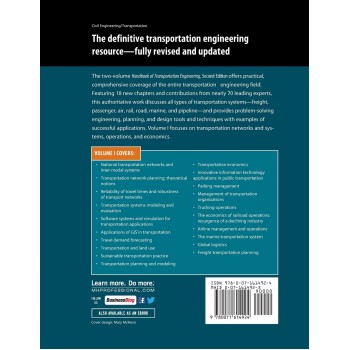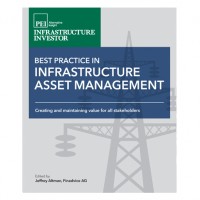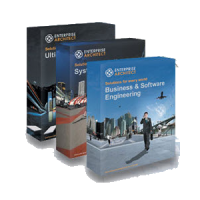Handbook of Transportation Engineering - Volume I and II
The Definitive Transportation Engineering Resource
Transportation systems of regional and national extent are composed of networks of interconnected facilities and services. It follows that nearly all transportation projects must be analyzed with due consideration for their position within a modal or intermodal network, and for their impacts on network performance. That is, the network context of a transportation project is usually very important. Thus, it is appropriate to begin a volume on transportation engineering with a chapter on national transportation networks.
The two-volume Handbook of Transportation Engineering, Second Edition offers practical, comprehensive coverage of the entire transportation engineering field. Featuring 18 new chapters and contributions from nearly 70 leading experts, this authoritative work discusses all types of transportation systems―freight, passenger, air, rail, road, marine, and pipeline―and provides problem-solving engineering, planning, and design tools and techniques with examples of successful applications. Volume I focuses on transportation networks and systems, operations, and economics. Volume II focuses on applications in automobile and non-automobile transportation, and on safety and environmental issues.
Volume I covers:
National transportation networks and inter-modal systems; Transportation network planning: theoretical notions; Reliability of travel times and robustness of transport networks; Transportation systems modeling and evaluation; Software systems and simulation for transportation applications; Applications of GIS in transportation; Travel demand forecasting; Transportation and land use; Sustainable transportation practice; Transportation planning and modeling; Transportation economics; Innovative information technology applications in public transportation; Parking management; Trucking operations; The economics of railroad operations: resurgence of a declining industry; Airline management and operations; The marine transportation system; Global logistics; Freight transportation planning; Management of transportation organizations;
Volume II covers:
Traffic engineering analysis; Traffic origin-destination estimation; Traffic congestion; Highway capacity; Traffic control systems: freeway management and communications; Traffic signals; Highway sign visibility; Transportation lighting; Geometric design of streets and highways; Intersection and interchange design; Pavement engineering: flexible and rigid pavements; Pavement testing and evaluation; Bridge engineering; Tunnel engineering; Pedestrians; Bicycle transportation; Spectrum of automated guideway transit (AGT) and its applications; Railway vehicle engineering; Railway track design; Improvement of railroad yard operations; Modern aircraft design techniques; Airport design; Air traffic control systems design; Ship design; Pipeline engineering; Traffic safety; Transportation hazards; Hazardous materials transportation; Incident management; Network security and survivability; Optimization of emergency evacuation plans; Transportation noise issues; Air quality issues in transportation; Transportation and climate change
About the Authors
Myer Kutz holds engineering degrees from MIT and RPI, served in the US Army, and has worked in aerospace and publishing. He was vice president for scientific and technical publishing at John Wiley & Sons. He has headed his own firm, Myer Kutz Associates, Inc., since 1990. For the past decade he has focused on developing engineering handbooks on a wide range of technical topics. He is also the author of eight books, including Rockefeller Power, published by Simon& Schuster, and Midtown North, published under the name Mike Curtis. He lives in Delmar, NY with his wife Arlene. They spend winters on Kiawah Island, SC. He has served as president of his co-op apartment building on Manhattan's Upper West Side and on the boards of several national organizations.

-350x350.png)
-350x350.png)
-350x350.png)
-350x350.png)



-200x200.jpg)















-200x200.jpg)












